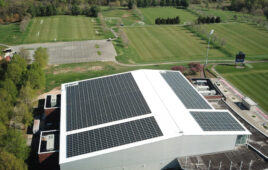The U.S. Department of Energy (DOE) today announced a new National Community Solar Partnership (NCSP) target to enable community solar systems to power the equivalent of five million households by 2025 and create $1 billion in energy bill savings. Reaching these milestones will help achieve the Biden-Harris Administration’s goals of achieving 100% clean electricity by 2035 and ensure that all Americans can reap the benefits of renewable energy while building community wealth and resiliency.
“Community solar is one of the most powerful tools we have to provide affordable solar energy to all American households, regardless of whether they own a home or have a roof suitable for solar panels,” said Sec. Jennifer M. Granholm. “Achieving these ambitious targets will lead to meaningful energy cost savings, create jobs in these communities, and make our clean energy transition more equitable.”
There is enough community solar installed in the U.S. today to power 600,000 households — achieving DOE’s new NSCP target would mean an increase of more than 700% in the next four years. The recently released “Solar Futures Study” from DOE and the National Renewable Energy Laboratory shows how solar can play a major role in a decarbonized grid.
“Today’s announcement from Secretary Granholm demonstrates the overwhelming support that’s building for the role community solar should play in transforming and strengthening our energy grid while expanding access to solar for all,” said Jeff Cramer, executive director for Coalition for Community Solar Access, in a statement. “We know customers want distributed solar energy and that local solar brings significant societal and grid benefits, but we need strong policies and goals to bring those benefits to fruition. DOE’s goal of 26 GW by 2025 is consistent with the accelerated growth that our research shows is needed for the community solar industry to meet our climate goals at the lowest cost. Congress and state policymakers should listen to the DOE and do their part to accelerate the growth of community solar so we can build a clean, cost-effective electric grid that works for all Americans.”
The NCSP is a DOE initiative led by the Solar Energy Technologies Office, in collaboration with the NREL and Lawrence Berkeley National Laboratory. The partnership includes a coalition of community solar stakeholders, such as state, local and Tribal governments, solar developers and community-based organizations, working to expand access to affordable community solar to every American household. Partners leverage peer networks as well as technical assistance funding and resources to overcome the persistent barriers to expanding community solar access with a focus on those in underserved communities. As of September 2021, NCSP had over 650 members from over 440 partner organizations.
The ‘Sharing the Sun’ report released by NREL in collaboration with NCSP shows that community solar can lead to substantial bill savings — from 5 to 25%. Achieving $1 billion in cost savings would mean that, on average, community solar projects would provide a 20% bill savings. This target, along with other potential solutions for equitable community solar deployment, was informed by NCSP stakeholders in a recent request for information.
To achieve these new targets, DOE is offering free, on-demand technical assistance to NCSP partnership members. Technical assistance provides personalized support to organizations deploying community solar to help them accelerate implementation, improve the performance of their program or project, and build capacity for future community solar development. NCSP has already distributed $1 million for technical assistance and hopes to provide $2 million in the next year.
News item from DOE




Do you have a tool kit(s) that help explain how to create a community solar projects from the perspective of;
a citizen who would click to join as a partner to receive green energy
a politician wanting to create policy as well as projects to support low and moderate incomes
developers who want to build these projects.
How do we make community solar happen now!
The “Solar Futures Study” is firming up the drive towards (buildings) “all electrification” and the concept of a future replacement of ICE transportation with BEV transportation. The EIA likes to report the yearly energy consumption in the U.S. in quadrillion BTUs per year. Right now the U.S. is using right around 100 quadrillion BTUs a year or 100 ‘quads’. Combined for building and transportation that’s around 76% to 80% of all energy used in the U.S. energy budget and puts one at the task of capturing and generating 76 to 80 quads a year. In this use case, the more individual distributed solar PV and or wind generation with energy storage, the more efficient and capable energy generation, storage and dispatch will be.